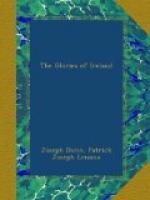Rouen, in Normandy, felt the influence of the Irish monks through the instrumentality of St. Ouen; and the monasteries of Jouarre, Rebais, Jumieges, Leuconaus, and St. Vandrille were due at least indirectly to Columbanus or his disciples.
Turning to Belgium, it is recorded that St. Romold preached the faith in Mechlin, and St. Livinus in Ghent. Both came from Ireland.
St. Virgilius, a voluntary exile from Erin, “for the love of Christ”, established his monastery at Salzburg, in Austria. He became bishop there, and died in 781.
Moreover, the Celtic Rule of Columbanus was carried into Picardy by St. Valery, St. Omer, St. Bertin, St. Mummolin, and St. Valdelenus; but the Irish Caidoc and Fricor had already preceded them, their work resulting in the foundation of the Abbey of St. Riquier.
Italy: Something yet remains to be said of the monks of Ireland in Italy. Anterior to St. Columbanus’s migration, his fellow countryman, St. Frigidian (or Fridian), had taken up his abode in Italy at Monte Pisana, not far from the city of Lucca, where he became famed for sanctity and wisdom. On the death of the bishop of Lucca, Frigidian was compelled to occupy the vacant see. St. Gregory the Great wrote of him that “he was a man of rare virtue”. His teachings and holy life not only influenced the lives of his own flock, but brought to the faith many heretics and pagans. In Lucca this Celtic apostle is still honored under the name of St. Frediano.
St. Pellegrinus is another Irish saint who sought solitude at Garfanana in the Apennines; and Cathaldus, a Waterford saint, in 680, became Bishop of Taranto, which he governed for many years with zeal and great wisdom. His co-worker was Donatus, his brother, who founded the church at Lecce in the Kingdom of Naples.
Of the two learned Irishmen, Clemens and Albinus, who resided in France in the eighth century, Albinus was sent into Italy, where at Pavia he was placed at the head of the school attached to St. Augustine’s monastery. Dungal, his compatriot, was a famous teacher in the same city. Lothair thus ordained concerning him: “We desire that at Pavia, and under the superintendence of Dungal, all students should assemble from Milan, Brescia, Lodi, Bergamo, Novara, Vercelli, Tortona, Acqui, Genoa, Asti, Como.”
It was this same Dungal who presented the Bangor psalter to Bobbio; therefore it may be reasonably conjectured that he came from the very monastery that produced Columbanus, Gall, and Comgall.
Fiesole, in Tuscany, venerates two Irish eighth-century saints, Donatus and Andrew. The former was educated at Iniscaltra, and Andrew was his friend and disciple. After visiting Rome, they lingered at Fiesole. Donatus was received with great honor by clergy and people and was requested to fill their vacant bishopric. With much hesitation he took upon himself ihe burden, which he bore for many years. His biographer says of him that “he was liberal in almsgiving, sedulous in watching, devout in prayer, excellent in doctrine, ready in speech, holy in life.” Andrew, who was his deacon, founded the church and monastery of St. Martin in Mensola, and is known in Fiesole as St. Andrew of Ireland, or St. Andrew the Scot, that is, the Irishman.




